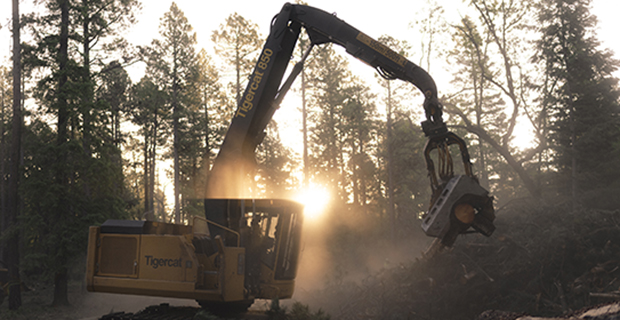SRP, partners clearing forests to prevent wildfires

The Salt River Project is funding a new healthy fuels initiative north of Payson to prevent catastrophic wildfires and build water resiliency amidst the worst drought in state history.
SRP, in coordination with Arizona Department of Forestry and Fire Management, the U.S. Forest Service and the town of Payson, is working on a strategic forest thinning project to protect a 1,010 acre-area in the Cragin Watershed Reduction Project, which supplies water to the C.C. Cragin Reservoir, said SRP forest health management principal Elvy Barton. That acre-area is the equivalent of the size of slightly less than 1/16th the area of the South Mountain Park and Preserve.
The Baker Hazardous Fuels Reduction Project is estimated to cost SRP, as well as public and private contractors, between $700,000 and $900,000 when completed, Barton said.
“This is just a new opportunity for us to invest really in more on-the-ground projects that are going to have landscape-scale positive benefits,” she said.
It will support the safety of communities in northeastern Arizona, including Payson, Pine and Strawberry, through a hazard fuels mitigation grant – one of many funding programs the forestry department oversees to safeguard communities at risk of wildland fires, said Tiffany Davila, the forestry department public affairs officer.
The Baker Hazardous Fuels Reduction Project will help to reduce the amount of fuel in the Coconino National Forest that leads to wildfires while protecting the area’s C.C. Cragin Reservoir and local wildlife habitats, Davila said.
David Tenney, director of the Arizona Department of Forestry and Fire Management, testified last summer during a special legislative session on wildfires about the importance of being proactive.
“Reacting to a disaster is one thing… But I argue it’s better to do all that we can to prevent a fire in the first place, Tenney said.
Gov. Doug Ducey signed House Bill 2001, a bipartisan wildfire relief package, last June, saying his goal was to “get more boots on the ground,” calling the omnibus legislation “a win-win.” The $100 million bill includes $2.25 million for the forestry department to provide hazardous vegetation removal, with the money taken from the state general fund in fiscal year 2021.
House Rep. Gail Griffin, R-Sierra Vista, led the initiative after more than 975,000 acres of state wildland burned in 2020, which is an area that is about equivalent to the size of 61 South Mountain Park and Preserves, according to state forester data. It was the second worst burn-year per acreage in state history, including the Telegraph and Mescal fires, which merged near the edge of the Tonto National Forest, Tenney said.
Tenney said the wildfire stabilization plan is an “innovative approach,” to provide his agency financial resources to “restore our landscapes and reduce fossil fuels,” by a 500 percent projected-increase in the number of acres receiving vegetation removal.
“We keep pushing, generally, for the federal government to allow the thinning of more forest property,” said House Speaker Rusty Bowers, R-Mesa, who co-sponsored the bill.
Bowers, who is running for election in the state Senate to represent the newly drawn legislative District 10, said he thinks having ponderosa pines clear when people are around inhabited areas and highways “is part of our function, but also much of why the federal government” started the USFS’ Four Forest Restoration Initiative.
The initiative is a statewide collaborative effort between the Arizona Commerce Authority, U.S. Bureau of Land Reclamation, the forestry department and the USDA, that aims to restore stable forest structure and functions to the ponderosa pine system in northern Arizona.
“We should be doing [strategic forest thinning] everywhere,” Bowers said.
Within the Rim Country region, water from the reservoir gets pumped over the Mogollon Rim to the East Verde River and to a pipeline that supplies Cragin water to the town of Payson, according to SRP. Water released from the Cragin also serves the Phoenix metropolitan area. The watershed is most at risk because the reservoir is SRP’s only one in a dam surrounded by ponderosa pine trees, Barton said.
Tanner Henry, water superintendent for the town of Payson, said he is concerned about the amount of water leaving the reservoir. Payson receives 54% of its water resources – roughly 3,000 acre-feet per year or enough to serve 6,000 to 12,000 homes annually – from the Cragin, totaling 27.2% annually, Henry said.
“What’s at stake for the community is our sustainability,” he said.
The baseline state of forest in a high elevation ecosystem, such as Payson, has become too densely packed with ponderosa pines over time, according to Gwen Iacona, assistant director of Arizona State University’s Center for Biodiversity Outcomes.
In a very dry spell, fast winds contribute to easy burning on the tree crowns, which is where the plant meets the roots, Iacona said.
“It seems counterintuitive,” she said of the risk reduction program. “But, in this case, cutting trees is actually beneficial to making a healthier and more resilient forest.”
Barton said this project pioneers the first area of the Cragin Watershed Reduction Project to draw on SRP’s new partnership with the forestry department, which trained new inmate teams in May – under the state and U.S. Forest Service’s Good Neighbor Authority agreement – to implement forest thinning. That process aims to retain C.C. Cragin Reservoir’s water storage levels, protecting the watershed and delivering reliable water to residents for supply over long-term droughts, Barton said.
SRP delivers about 750,000 acre-feet of water to over 2 million residents in the Valley each year. That amount of water is enough to serve 1.5 to 3 million homes annually. When an “unhealthy forest” is at extreme wildfire risk, it contributes to sediment build up behind the dams, decreasing water quality, Barton said.
The final change instituted under HB2001 lies within a state statute now expanding Arizona’s power of the Good Neighborhood Authority. Last enhanced in 2018, the authority is a bipartisan congressional resolution on permanent wildfire funding for every state in the country.
